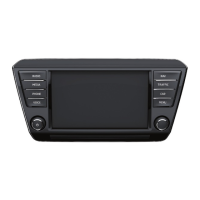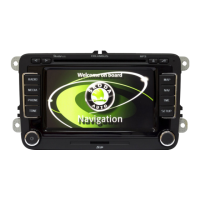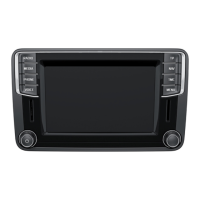Do you have a question about the Skoda COLUMBUS and is the answer not in the manual?
Explains the scope of the manual and its relation to vehicle equipment variants.
Details symbols used in the manual for navigation and section continuation.
Emphasizes driver concentration, safe volume levels, and potential hearing damage.
Outlines warranty terms and conditions for the equipment and exceptions.
Provides instructions and cautions for cleaning the display surface safely.
Explains the anti-theft coding system and the procedure for entering the code.
Describes how parking aid and Climatronic information display on the unit.
Details the physical buttons and functions of the radio navigation system.
Explains how to turn the system on/off and adjust audio volume.
Explains how to interact with the touch screen and move objects on the display.
Describes the on-screen keypad for entering text, numbers, and special characters.
Explains how to select special characters and alternative letter inputs.
Introduces the 'Speak what you see' voice control system for operating the unit.
Details methods for turning voice control on and off, including automatic deactivation.
Explains the dialogue period, audible feedback, and system guidance for voice commands.
Describes setting dialogue style and interrupting system messages for faster commands.
Lists available languages and provides general guidelines for using voice commands.
Details how to switch between RADIO, MEDIA, PHONE, MAP, and NAV modes using voice commands.
Explains how to access help, quick commands, and visual help for voice control.
Explains setting voice recordings and lists further voice commands for navigation.
Lists specific voice commands for RADIO, MEDIA, PHONE, MAP, and NAV operating modes.
Overview of the main setup menu and its function keys.
Settings for radio reception, station lists, and RDS/TP functions.
Settings for external audio/video sources, Bluetooth, and media playback options.
Settings for phone book, SMS, language, date, and factory resets.
Settings for screen brightness, day/night mode, and map display options.
Settings for route calculation, traffic information, and navigation announcements.
Settings for voice command dialogue style and video output languages.
Settings for DVD aspect ratio and TV reception modes.
Overview of the main radio screen and its function keys.
Allows switching between FM/AM bands and accessing station lists.
Accesses saved radio stations stored in preset lists.
Provides Scan, TP, display switch-off, and manual tuning options.
Explains how to activate traffic alerts and identifies TMC stations.
Overview of the Media mode, showing available sources and playback controls.
Details the different audio sources like CD, SD, HDD, and AUX input.
Accesses video sources, including TV and DVD playback.
Explains playback options like Repeat, Mix, Scan, and Selection.
Details HDD storage, unit buttons for playback, and condensation notes.
Information on MP3/WMA data, requirements, and memory card handling.
Details connecting external audio sources via AUX, MDI, and iPod.
Lists connection requirements and provides safety warnings for external sources.
Instructions for inserting and starting Video-DVDs, and navigating the DVD menu.
Explains DVD menu access, display adjustments, chapter navigation, and pause.
Explains DVB-T, Hybrid tuner, and how TV stations are displayed and managed.
Describes TV menu, Video Text display, and Electronic Program Guide (EPG).
Introduces the PHONE mode and its functions.
Displays the main menu for phone operations and connected devices.
Explains telephone book, searching, phone conversations, and call waiting.
Details setting up conference calls and using DTMF tones for selections.
Describes the SMS menu for reading, writing, and sending text messages.
Overview of sound adjustment options available.
Settings for Bass, Mid, and Treble frequencies.
Adjustments for sound balance, fader, switch-on volume, and traffic alerts.
Explains automatic volume adjustment and confirmation tone settings.
Selection of equalizer presets and surround sound settings.
Overview of map display modes, including full-screen and split-screen.
Options to switch between 2D/3D views and adjust map scale.
Accesses navigation guidance, POI selection, and lane guidance.
Describes map panning, vehicle position, destination symbols, and display settings.
Advises observing traffic regulations and potential data discrepancies.
Emphasizes safe operation and volume adjustment during driving.
Details route recalculation, incomplete data, and critical safety warnings.
Explains the 'Navigation' function key for route guidance and options.
Sets route calculation preferences and chooses between Tour and Waypoint modes.
Enters addresses, searches POIs, and specifies destinations via map or GPS.
Accesses and manages Home, Last, Fav., and memory destinations for guidance.
Details saving, editing, and managing tours and waypoint navigation.
Manually blocks roads and uses TMC for dynamic route adjustments.
Details TMC requirements for traffic information and provides usage notes.
How TMC traffic reports are displayed during route guidance.
Provides information on TMC station background operation and data accuracy.
Explains the scope of the manual and its relation to vehicle equipment variants.
Details symbols used in the manual for navigation and section continuation.
Emphasizes driver concentration, safe volume levels, and potential hearing damage.
Outlines warranty terms and conditions for the equipment and exceptions.
Provides instructions and cautions for cleaning the display surface safely.
Explains the anti-theft coding system and the procedure for entering the code.
Describes how parking aid and Climatronic information display on the unit.
Details the physical buttons and functions of the radio navigation system.
Explains how to turn the system on/off and adjust audio volume.
Explains how to interact with the touch screen and move objects on the display.
Describes the on-screen keypad for entering text, numbers, and special characters.
Explains how to select special characters and alternative letter inputs.
Introduces the 'Speak what you see' voice control system for operating the unit.
Details methods for turning voice control on and off, including automatic deactivation.
Explains the dialogue period, audible feedback, and system guidance for voice commands.
Describes setting dialogue style and interrupting system messages for faster commands.
Lists available languages and provides general guidelines for using voice commands.
Details how to switch between RADIO, MEDIA, PHONE, MAP, and NAV modes using voice commands.
Explains how to access help, quick commands, and visual help for voice control.
Explains setting voice recordings and lists further voice commands for navigation.
Lists specific voice commands for RADIO, MEDIA, PHONE, MAP, and NAV operating modes.
Overview of the main setup menu and its function keys.
Settings for radio reception, station lists, and RDS/TP functions.
Settings for external audio/video sources, Bluetooth, and media playback options.
Settings for phone book, SMS, language, date, and factory resets.
Settings for screen brightness, day/night mode, and map display options.
Settings for route calculation, traffic information, and navigation announcements.
Settings for voice command dialogue style and video output languages.
Settings for DVD aspect ratio and TV reception modes.
Overview of the main radio screen and its function keys.
Allows switching between FM/AM bands and accessing station lists.
Accesses saved radio stations stored in preset lists.
Provides Scan, TP, display switch-off, and manual tuning options.
Explains how to activate traffic alerts and identifies TMC stations.
Overview of the Media mode, showing available sources and playback controls.
Details the different audio sources like CD, SD, HDD, and AUX input.
Accesses video sources, including TV and DVD playback.
Explains playback options like Repeat, Mix, Scan, and Selection.
Details HDD storage, unit buttons for playback, and condensation notes.
Information on MP3/WMA data, requirements, and memory card handling.
Details connecting external audio sources via AUX, MDI, and iPod.
Lists connection requirements and provides safety warnings for external sources.
Instructions for inserting and starting Video-DVDs, and navigating the DVD menu.
Explains DVD menu access, display adjustments, chapter navigation, and pause.
Explains DVB-T, Hybrid tuner, and how TV stations are displayed and managed.
Describes TV menu, Video Text display, and Electronic Program Guide (EPG).
Introduces the PHONE mode and its functions.
Displays the main menu for phone operations and connected devices.
Explains telephone book, searching, phone conversations, and call waiting.
Details setting up conference calls and using DTMF tones for selections.
Describes the SMS menu for reading, writing, and sending text messages.
Overview of sound adjustment options available.
Settings for Bass, Mid, and Treble frequencies.
Adjustments for sound balance, fader, switch-on volume, and traffic alerts.
Explains automatic volume adjustment and confirmation tone settings.
Selection of equalizer presets and surround sound settings.
Overview of map display modes, including full-screen and split-screen.
Options to switch between 2D/3D views and adjust map scale.
Accesses navigation guidance, POI selection, and lane guidance.
Describes map panning, vehicle position, destination symbols, and display settings.
Advises observing traffic regulations and potential data discrepancies.
Emphasizes safe operation and volume adjustment during driving.
Details route recalculation, incomplete data, and critical safety warnings.
Explains the 'Navigation' function key for route guidance and options.
Sets route calculation preferences and chooses between Tour and Waypoint modes.
Enters addresses, searches POIs, and specifies destinations via map or GPS.
Accesses and manages Home, Last, Fav., and memory destinations for guidance.
Details saving, editing, and managing tours and waypoint navigation.
Manually blocks roads and uses TMC for dynamic route adjustments.
Details TMC requirements for traffic information and provides usage notes.
How TMC traffic reports are displayed during route guidance.
Provides information on TMC station background operation and data accuracy.
| Brand | Skoda |
|---|---|
| Model | COLUMBUS |
| Category | Car Navigation system |
| Language | English |








